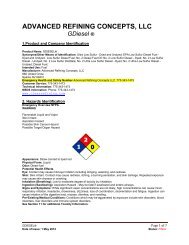The Next Generation Diesel Fuel? - Advanced Refining Concepts
The Next Generation Diesel Fuel? - Advanced Refining Concepts
The Next Generation Diesel Fuel? - Advanced Refining Concepts
You also want an ePaper? Increase the reach of your titles
YUMPU automatically turns print PDFs into web optimized ePapers that Google loves.
This is the first of many tanker trucks planned for delivering G<strong>Diesel</strong> to both fleet owners and fuel blenders. Details on retail distribution to consumers are still being ironed out.<br />
cetane properties of G<strong>Diesel</strong> just meet the requirements of a No.<br />
1 diesel, but could be enhanced further with an additive.<br />
Moreover, unlike biodiesel, which has been found to gel at a<br />
comparatively high temperature (depending on the feedstock),<br />
G<strong>Diesel</strong> has an extremely low cloud point of -53 degrees C.<br />
How It Works<br />
How does ARC achieve these levels of clarity and performance?<br />
<strong>The</strong> basics of the Clear <strong>Refining</strong> process are fairly<br />
straightforward, something a high school chemistry student<br />
could grasp. It starts out with a standard diesel fuel that you’d<br />
buy at the pump, slightly pressurized in an industrial tank to 5<br />
psi and heated to 300 degrees. Natural gas (methane), the same<br />
type used for cooking and heating, is then fed into the diesel,<br />
and the resulting mixture swirls through a circular wire mesh<br />
containing four different metal catalysts (cobalt, among others).<br />
As you might recall from your chemistry class, a catalyst is a<br />
substance that starts or speeds up a chemical reaction, but doesn’t<br />
undergo any permanent change in itself. Hence, these catalysts<br />
(which look like wire wrapped around the spokes of a large<br />
metallic wheel), don’t actually become part of the fuel, as proven<br />
by independent lab tests. <strong>The</strong> G<strong>Diesel</strong> then flows through a<br />
layer of plastic pellets to facilitate condensation, and then a heat<br />
exchanger for cooling. Lastly, the G<strong>Diesel</strong> flows through a 15micron<br />
filter before it’s pumped into a vehicle’s tank.<br />
When the oil/gas mixture reacts with the catalysts, Dr.<br />
Gunnerman says it forms longer fuel molecules, with the natural<br />
This schematic drawing shows the layout of the Clear <strong>Refining</strong> processor. <strong>The</strong> reaction<br />
tank on the left mixes the natural gas and diesel, flowing them through a mesh of metal<br />
catalysts. After this mixture condenses and cools, using a chiller unit between the two<br />
tanks, the product tank on the right collects the resulting G<strong>Diesel</strong>.<br />
gas becoming part of the liquid diesel. Note that this comparatively<br />
low-energy conversion is not the same as the Fischer-<br />
Tropsch gas-to-liquid (GTL) process used to make diesel from<br />
gas, since the chemistry involved is different. While the specific<br />
details of ARC’s patent-pending process are confidential, the<br />
results are obvious.<br />
G<strong>Diesel</strong> looks purer and more refined than the original diesel<br />
feedstock, as the photos attest. Conventional diesel is yellowish<br />
in color, while G<strong>Diesel</strong> is as clear as bottled water. During the<br />
90 APRIL 2010 • DIESEL WORLD www.dieselworldmag.com



